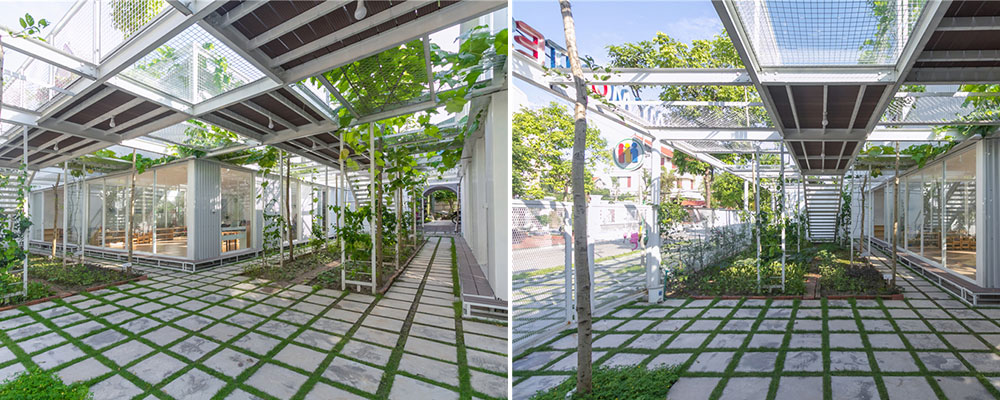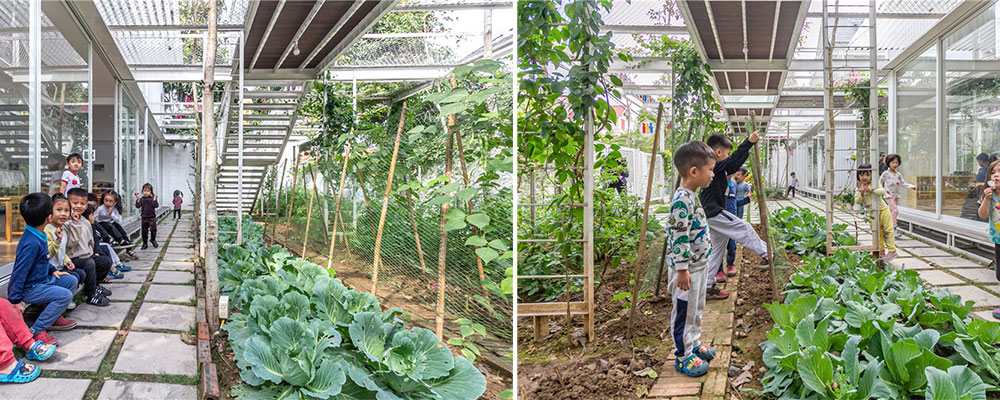Planting areas are an important part of environmental education in kindergarten outdoor games. The planting area is the epitome of nature, not only has the role of greening and beautifying the environment but also contains a great educational value, which can help children observe nature and explore the wonderful world.
Below, let’s take a look at the importance of creating growing areas for children’s development.

First, the creation of a planting area helps children to gain the initial experience of nature and science
In the nursery planting area, children can discover problems, discuss problems, gain knowledge and experience, and experience the fun of activities. According to the actual situation of the kindergarten, we can set up two types of planting areas, indoor and outdoor.
Set a natural corner in the activity room. We use potted ways, plant flowers and trees, and “subcontract” to each child. The children take good care of their flowers and plants every day and observe their growth. One day, when a child was watering a green plant, he accidentally broke a delicate branch and put it into a hydroponic glass bottle nearby. After a week, he was pleasantly surprised to find that not only did the branch not wither, but also grew roots. Excited, he called his friends to observe.

Second, the creation of a planting area helps children to understand the close relationship between plants and people, and cultivate the character of love for work from childhood
After a while, they argued about whether the leaves would take root. I suggested they pick a few leaves to test it. After some time, they found that one leaf had really taken root, and they reported it to me with shouts and jumps. I was as happy as they were — not only had the children learned that the plant could be grown in water, but the leaves could also take root, which was a new discovery.
Set up a planting area outside the event area. Small kindergartens can, on the premise of ensuring safety, open up a planting garden on the roof, delimit the area, and “subcontract” to each class so that children can cultivate the quality of love and labor and a sense of collective honor through a series of activities such as sowing, management, and harvesting. Each class can plant vegetables, sweet potatoes, peanuts, and other crops according to different seasons.

In this process, children through their own observation and exploration, understand the names of different plants and their growth process and change rules. For example, we discussed whether the low wheat seedlings could survive the cold winter, observed the whole process of wheat from heading to grain-filling, seed-bearing, and harvest, and felt a wonderful nature and the indomitable vitality of plants.
Children are natural inquirers, who constantly explore the world around them and enrich their knowledge from birth. In the “Joy of Harvest” activity, children picked vegetables from the kitchen, with the help of the teacher, make “food”, and experience the joy of harvest. After harvesting the wheat, the children watched the wheat being ground into flour and began to participate in it. They made different kinds of flour together with the teacher. They understood that all kinds of plants are closely related to the human diet, and understood why we should cherish food and love labor.
Third, the creation of a planting area can stimulate children's pursuit of observing and expressing beauty
The children have their own growing areas, growing attention, and enthusiasm, showing a strong curiosity and thirst for knowledge. It would be even better if art tools and rich paint were provided in the planting area to guide children to show the growth and changes of plants through painting. Many children like the drawing board in the growing area most and go there to paint almost every day. For example, through long-term observation, they draw the whole process of rape from germination to flowering, draw the cover and write their own names. Teachers can bind these pictures and let children have their first “picture book of life”.

The planting area is created to provide the conditions for children to get close to nature. Here, the children work together, feel the harmonious coexistence between people and nature, and gradually cultivate the love of nature and love of life, develop the habit of respecting life and protecting the environment.
Kindergarten Outdoor Games Are An Important Part Of Environmental Education
Playing outdoors is a wonderful way to instill environmental education in kindergartners and get them excited about exploring the natural environment. From creative scavenger hunts to imaginative nature hikes and seed-planting activities, our guide offers plenty of ideas for fun kindergarten outdoor games that are suitable for young children.
Take Nature Hikes
Nature hikes are a great way to get kindergartners out in the open and let them explore the natural environment. Set up trails through nearby plants, trees, flowers, and other natural environments for them to explore, or create fun educational activities for them to complete along the way. Riddles about bugs and birds can help teach kindergartners about the wildlife in their area, while tasks such as finding hidden items or identifying different leaves can be both educational and entertaining.
Plant Trees and Flowers
Planting areas are an important part of environmental education in kindergartens. With a little supervision, kindergartners can learn the basics of gardening and get to see the fruits of their labor grow over time. Start simple by having them plant small vegetables or flowers, which they can then take home to show off! It’s a great way to promote environmental care and foster an appreciation for nature.
Explore Insects and Animals Inhabiting the Area
While gardening is fun and educational, don’t forget the other aspects of nature. Have kindergartners explore the outdoors and go on a bug hunt! Let them observe insects in their environment, simulate animal habitats and track their movements, or simply identify the different animals living in their area. Not only will this introduction to ecology be valuable for many future lessons but it can also be a great bonding experience for teachers and students who rarely get to explore the outdoors.
Construct Bird Feeders or Bird Houses
Give kindergartners a chance to explore their creative side and construct small bird feeders or houses for the birds in their area. You can provide other materials like paper, twigs, and pinecones so that they can design their own little structures. In addition to being a fun activity, kindergartens can appreciate the importance of humanely providing resources for wildlife living in the community. This is also a great way to introduce children to the concept of conserving nature and raising awareness about animals in need.
Learn about Recycling, Composting, or Worm Fertilizing Practices for a Mini Kitchen Garden Project
Planting area activities can also serve as an excellent opportunity to teach kindergartners about simple, easy-to-implement sustainable practices like recycling, composting, and worm fertilizing. Organize a mini kitchen garden project by helping kids design their own plant pots made with recycled materials like plastic containers or boxes. They will get excited to see the results of the composting process and will learn the importance of reusing resources for the health of the planet. Then watch as they enjoy themselves while planting sunflower seeds and more!

